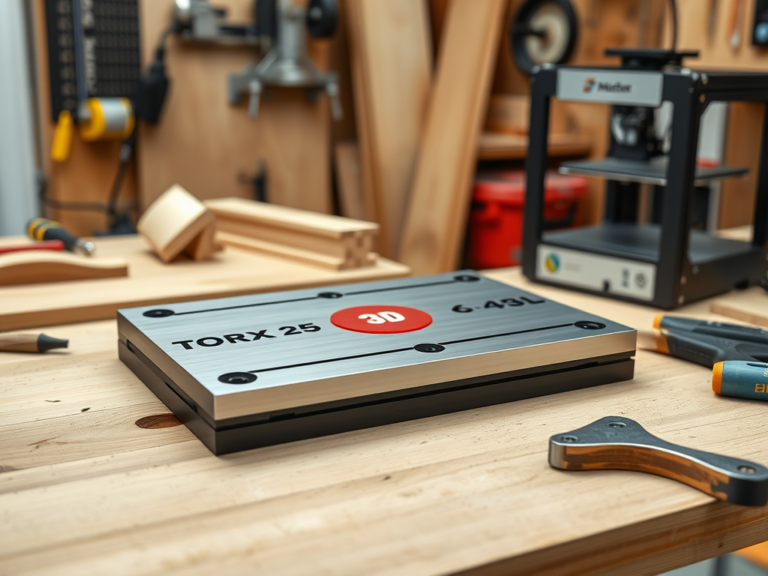
Introduction
In this guide, we’ll explore how to design, print, and use a 3d-printed Torx 25 router plate, the best materials to use, and troubleshooting tips to ensure a smooth experience. In the fields of CNC machining and woodworking, a Torx 25 router plate is a necessary tool that guarantees accuracy, stability, and efficiency. Thanks to developments in 3D printing, custom Torx 25 router plate construction has never been simpler. Whether your inclination is a DIY or professional carpenter, 3D printing allows you to create high-quality, durable, and customised router plates at a fraction of the cost.

Post-Processing & Assembly
1. Sanding and Smoothing
- Use fine-grit sandpaper to remove layer lines.
- Apply acetone smoothing for ABS prints.
2. Reinforcing the Plate
- Consider using an epoxy coating or metal inserts for added strength.
- Use Torx 25 screws for secure mounting.
3. Testing & Adjustments
- Fit the plate onto your router and workbench.
- Check for precision and alignment.
- Modify settings and reprint if needed.
Why 3D Print a Torx 25 Router Plate?
1. Financial Reductions
Especially in cases of customisation, pre-manufactured router plates might be costly. Using 3D printing lets you save money and produce a plate appropriate to your particular requirements.
2. Modification and Adaptability
A router plate designed for your specific router model, table size, and application can be created by you. CAD tools let one quickly change custom hole placements, thicknesses, and features.
3. Excellent repeatability and precision.
High-accuracy modern 3D printers guarantee that every router plate has constant quality and specifications.
4. Durable & Lightweight Choices
By selecting the right materials, you can produce a robust and lightweight router plate that is resistant to the stresses of woodworking.
Top Materials for 3D Printing a Router Plate
The durability, rigidity, and lifespan of the router plate depend on choosing the correct filament or resin.
1. PLA (polylactic acid)
- Pros: great dimensional precision; simple printing techniques.
- Cons: Not fit for heavy-duty uses; brittle.
2. PETG (Polyethene Terephthalate Glycol-Modified)
- Pros: Stronger than PLA, flexible, and impact-resistant.
- Cons: Slightly more challenging to print than PLA.
3. ABS (Acrylonitrile Butadiene Styrene)
- Pros: Durable, heat-resistant, and strong.
- Cons: Prone to warping, requires a heated bed.
4. Nylon
- Pros: Extremely durable and flexible, excellent for high-stress applications.
- Cons: Absorbs moisture and requires high print temperatures.
5. Resin (SLA Printing)
- Pros: High detail precision, excellent for intricate designs.
- Cons: Brittle compared to FDM materials, requires post-curing.
Creating a 3D-Printed Torx 25 Router Plate: Measuring Work Surface and Router
Verify the exact base measurement of your router.
- Factor thickness, guide slots, and mounting hole locations.
2. Using CAD Software
- Recommended programs: Fusion 360, Tinkercad, Freecad.
- Design with Torx 25 screw slots, guide rails, and mounting holes.
3. Strengthening the Design
- Add reinforcement ribs to prevent flexing.
- Use filleted edges to distribute stress evenly.
4. Exporting and Slicing the Model
- Save the STL file.
- Import it into Cura, PrusaSlicer, or Simplify3d.
- Adjust settings for optimal print quality.
Best 3D Printing Settings for a Router Plate
1. Nozzle Size
- 0.4mm to 0.6mm nozzle for a balance between detail and strength.
2. Layer Height
- 0.2mm layer height for high resolution.
- 0.3mm for faster prints.
3. Infill Density
- 40-60% infill for strong but lightweight parts.
4. Print Speed
- 50-70mm/s to avoid defects.
5. Bed Adhesion
- Use a heated bed for PETG, ABS, and Nylon.
- Apply a glue stick or PEI sheet for better adhesion.
READ MORE – Ultimate DIY Guide: How to 3D Print a Torx 25 Router Jig for Precision Routing
FAQs:
1. Can a 3d-printed router plate handle heavy-duty work?
Yes, when printed with PETG, ABS, or Nylon, the plate can withstand moderate workloads.
2. How do I prevent my 3d-printed router plate from breaking?
Reinforce stress points, increase wall thickness, and use higher infill percentages.
3. Can I use a budget 3D printer for a router plate?
Yes, most FDM 3D printers can handle router plate designs with proper calibration.
4. Is it better to 3d print a router plate or buy a commercial one?
If you need customisation, 3D printing is the best option. However, commercial plates offer higher durability.
5. In a 3d-printed router plate, how can accuracy be improved?
Apply strict tolerances in post-processing methods, high-resolution printing, and CAD.
Conclusion:
One great approach to personalising and improving your woodworking equipment is 3d printing a Torx 25 router plate. A 3d-printed router plate can be as successful as commercially sold ones with the correct materials, print settings, and reinforcing techniques. Whether you enjoy DIY projects or are a professional woodworker, this tutorial provides the information you need to create a premium, authentic Torx 25 router plate.